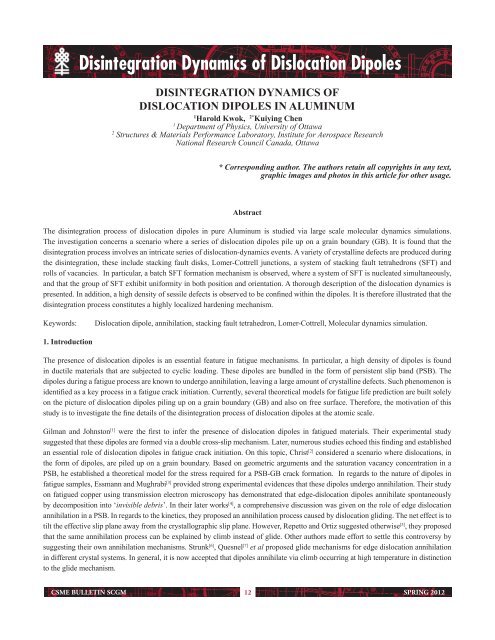Disintegration Dynamics of Dislocation Dipoles in Aluminum - CSME
Disintegration Dynamics of Dislocation Dipoles in Aluminum - CSME
Disintegration Dynamics of Dislocation Dipoles in Aluminum - CSME
Create successful ePaper yourself
Turn your PDF publications into a flip-book with our unique Google optimized e-Paper software.
<strong>Dis<strong>in</strong>tegration</strong> <strong>Dynamics</strong> <strong>of</strong> <strong>Dislocation</strong> <strong>Dipoles</strong><br />
* Correspond<strong>in</strong>g author. The authors reta<strong>in</strong> all copyrights <strong>in</strong> any text,<br />
graphic images and photos <strong>in</strong> this article for other usage.<br />
Abstract<br />
The dis<strong>in</strong>tegration process <strong>of</strong> dislocation dipoles <strong>in</strong> pure Alum<strong>in</strong>um is studied via large scale molecular dynamics simulations.<br />
The <strong>in</strong>vestigation concerns a scenario where a series <strong>of</strong> dislocation dipoles pile up on a gra<strong>in</strong> boundary (GB). It is found that the<br />
dis<strong>in</strong>tegration process <strong>in</strong>volves an <strong>in</strong>tricate series <strong>of</strong> dislocation-dynamics events. A variety <strong>of</strong> crystall<strong>in</strong>e defects are produced dur<strong>in</strong>g<br />
the dis<strong>in</strong>tegration, these <strong>in</strong>clude stack<strong>in</strong>g fault disks, Lomer-Cottrell junctions, a system <strong>of</strong> stack<strong>in</strong>g fault tetrahedrons (SFT) and<br />
rolls <strong>of</strong> vacancies. In particular, a batch SFT formation mechanism is observed, where a system <strong>of</strong> SFT is nucleated simultaneously,<br />
and that the group <strong>of</strong> SFT exhibit uniformity <strong>in</strong> both position and orientation. A thorough description <strong>of</strong> the dislocation dynamics is<br />
presented. In addition, a high density <strong>of</strong> sessile defects is observed to be conf<strong>in</strong>ed with<strong>in</strong> the dipoles. It is therefore illustrated that the<br />
dis<strong>in</strong>tegration process constitutes a highly localized harden<strong>in</strong>g mechanism.<br />
Keywords: <strong>Dislocation</strong> dipole, annihilation, stack<strong>in</strong>g fault tetrahedron, Lomer-Cottrell, Molecular dynamics simulation.<br />
1. <strong>in</strong>troduction<br />
diSiNtEgRAtioN dyNAmiCS <strong>of</strong><br />
diSloCAtioN dipolES iN AlumiNum<br />
1 harold kwok, 2* kuiy<strong>in</strong>g Chen<br />
1 Department <strong>of</strong> Physics, University <strong>of</strong> Ottawa<br />
2 Structures & Materials Performance Laboratory, Institute for Aerospace Research<br />
National Research Council Canada, Ottawa<br />
The presence <strong>of</strong> dislocation dipoles is an essential feature <strong>in</strong> fatigue mechanisms. In particular, a high density <strong>of</strong> dipoles is found<br />
<strong>in</strong> ductile materials that are subjected to cyclic load<strong>in</strong>g. These dipoles are bundled <strong>in</strong> the form <strong>of</strong> persistent slip band (PSB). The<br />
dipoles dur<strong>in</strong>g a fatigue process are known to undergo annihilation, leav<strong>in</strong>g a large amount <strong>of</strong> crystall<strong>in</strong>e defects. Such phenomenon is<br />
identified as a key process <strong>in</strong> a fatigue crack <strong>in</strong>itiation. Currently, several theoretical models for fatigue life prediction are built solely<br />
on the picture <strong>of</strong> dislocation dipoles pil<strong>in</strong>g up on a gra<strong>in</strong> boundary (GB) and also on free surface. Therefore, the motivation <strong>of</strong> this<br />
study is to <strong>in</strong>vestigate the f<strong>in</strong>e details <strong>of</strong> the dis<strong>in</strong>tegration process <strong>of</strong> dislocation dipoles at the atomic scale.<br />
Gilman and Johnston [1] were the first to <strong>in</strong>fer the presence <strong>of</strong> dislocation dipoles <strong>in</strong> fatigued materials. Their experimental study<br />
suggested that these dipoles are formed via a double cross-slip mechanism. Later, numerous studies echoed this f<strong>in</strong>d<strong>in</strong>g and established<br />
an essential role <strong>of</strong> dislocation dipoles <strong>in</strong> fatigue crack <strong>in</strong>itiation. On this topic, Christ [2] considered a scenario where dislocations, <strong>in</strong><br />
the form <strong>of</strong> dipoles, are piled up on a gra<strong>in</strong> boundary. Based on geometric arguments and the saturation vacancy concentration <strong>in</strong> a<br />
PSB, he established a theoretical model for the stress required for a PSB-GB crack formation. In regards to the nature <strong>of</strong> dipoles <strong>in</strong><br />
fatigue samples, Essmann and Mughrabi [3] provided strong experimental evidences that these dipoles undergo annihilation. Their study<br />
on fatigued copper us<strong>in</strong>g transmission electron microscopy has demonstrated that edge-dislocation dipoles annihilate spontaneously<br />
by decomposition <strong>in</strong>to ‘<strong>in</strong>visible debris’. In their later works [4] , a comprehensive discussion was given on the role <strong>of</strong> edge dislocation<br />
annihilation <strong>in</strong> a PSB. In regards to the k<strong>in</strong>etics, they proposed an annihilation process caused by dislocation glid<strong>in</strong>g. The net effect is to<br />
tilt the effective slip plane away from the crystallographic slip plane. However, Repetto and Ortiz suggested otherwise [5] , they proposed<br />
that the same annihilation process can be expla<strong>in</strong>ed by climb <strong>in</strong>stead <strong>of</strong> glide. Other authors made effort to settle this controversy by<br />
suggest<strong>in</strong>g their own annihilation mechanisms. Strunk [6] , Quesnel [7] et al proposed glide mechanisms for edge dislocation annihilation<br />
<strong>in</strong> different crystal systems. In general, it is now accepted that dipoles annihilate via climb occurr<strong>in</strong>g at high temperature <strong>in</strong> dist<strong>in</strong>ction<br />
to the glide mechanism.<br />
<strong>CSME</strong> BULLETIN SCGM 12<br />
SPRING 2012<br />
<strong>CSME</strong> Spr<strong>in</strong>g 2012.<strong>in</strong>dd 12 12-04-30 11:29 AM


